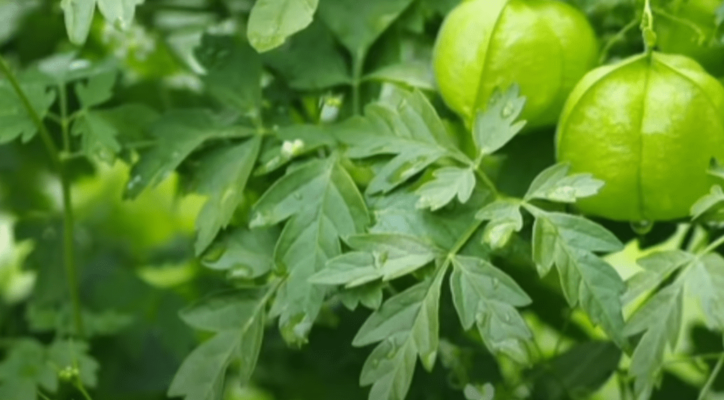Balloon Vine (Cardiospermum halicacabum) Discover the Nutrients & Health Benefits and Uses
Mudakathan keerai is the Tamil name and kanphata in Hindi.
Origin
Balloon vine, or Cardiospermum halicacabum, is not typically consumed as a food source by humans. While certain parts of the plant have been used in traditional medicine for their purported medicinal properties, there isn’t a widespread tradition of consuming balloon vine as a food.
However, it’s important to note that the plant has not been extensively studied for its safety or nutritional value as a food source. As a result, there isn’t sufficient information available to determine its suitability for human consumption.
In general, when considering the consumption of any plant or herbal remedy, it’s essential to exercise caution and consult reliable sources or healthcare professionals for guidance. While balloon vine may have traditional uses in certain cultures, its safety and potential side effects when ingested have not been thoroughly researched or established. Therefore, it’s advisable to avoid consuming balloon vine unless under the guidance of a knowledgeable healthcare provider.

Nutrients
Balloon vine, or Cardiospermum halicacabum, hasn’t been extensively studied for its nutritional composition. As a result, detailed information about its specific nutrient content is limited.
However, like many plants, balloon vine may contain some nutritional components, though they are likely to be in modest amounts. These components might include vitamins, minerals, and potentially some phytochemicals.
Calcium: Essential mineral important for bone health, muscle function, and nerve transmission.
Minerals: Essential nutrients required for various bodily functions, including electrolyte balance, enzyme function, and bone health.
Phosphorus: Vital mineral involved in bone and teeth formation, energy metabolism, and cell signaling.
Iron: Essential mineral necessary for the formation of hemoglobin in red blood cells, which carries oxygen throughout the body.
Protein: Important macronutrient essential for building and repairing tissues, producing enzymes and hormones, and supporting immune function.
Carbohydrates: Primary source of energy for the body, found in foods like grains, fruits, and vegetables.
Fat: Macronutrient important for energy storage, insulation, and the absorption of fat-soluble vitamins.
Phenols: Group of organic compounds with antioxidant properties, found in various plant-based foods and beverages.
Phenolic acids: Type of phenols found in plants, known for their antioxidant and anti-inflammatory properties.
Flavonoids: Group of phytonutrients with antioxidant and anti-inflammatory properties, commonly found in fruits, vegetables, and beverages like tea and wine.
Flavonoid glycosides: Flavonoids bound to sugar molecules, contributing to their stability and bioavailability.
Flavonoid glucuronides: Flavonoids conjugated with glucuronic acid in the liver, aiding in their metabolism and excretion.
Palmitic acid: Saturated fatty acid commonly found in both animal and plant fats.
Oleic acid: Monounsaturated fatty acid found in olive oil, nuts, and seeds, associated with heart health benefits.
Stearic acid: Saturated fatty acid found in various animal and plant fats, often neutral in its effect on cholesterol levels.
Linolenic acid: Essential omega-3 fatty acid important for brain function, heart health, and reducing inflammation.
Eicosenoic acid: Monounsaturated fatty acid found in certain plant oils and fish, with potential health benefits.
Arachidic acid: Saturated fatty acid found in some vegetable oils and animal fats, playing a role in cell structure and function.
Please consult your Doctor or Dietician before gobbling it up.

Benefits of Health
Balloon vine, or Cardiospermum halicacabum, is believed to have several potential health benefits, although scientific research on its medicinal properties is limited. Many of its purported health benefits are based on traditional use in various cultures. Here are some of the potential health benefits associated with balloon vine:
Anti-inflammatory Properties: Balloon vine has been traditionally used to alleviate inflammation and swelling associated with conditions such as arthritis, rheumatism, and other inflammatory disorders. Some compounds found in balloon vine may have anti-inflammatory effects, although further research is needed to confirm these properties.
Skin Disorders: Balloon vine has been used in traditional medicine to treat various skin conditions, including eczema, dermatitis, and itching. It is believed to have soothing and anti-itch properties, making it potentially beneficial for topical application to the skin.
Pain Relief: In certain traditional medicinal practices, balloon vine has been used to relieve pain associated with conditions such as joint pain, muscle aches, and minor injuries. Its analgesic properties may help alleviate discomfort, although more scientific evidence is needed to support these claims.
Antioxidant Activity: Balloon vine contains compounds with antioxidant properties, which can help neutralize harmful free radicals in the body and protect cells from oxidative damage.
Anti-allergic Effects:m Some traditional uses of balloon vine involve treating allergic reactions and respiratory conditions such as asthma and hay fever. It is believed to have anti-allergic properties that may help alleviate symptoms associated with allergic reactions, although scientific evidence supporting this claim is limited.
Traditional Wound Healing: Balloon vine has been used in certain cultures as a traditional remedy for promoting wound healing and relieving minor skin injuries. Its purported wound-healing properties may help facilitate the repair and regeneration of damaged tissues.
While balloon vine holds potential as a natural remedy for various health conditions, it’s important to emphasize that scientific research on its efficacy and safety is still limited. Before using balloon vine or any herbal remedy for medicinal purposes, it’s advisable to consult with a healthcare professional or qualified herbalist to ensure its appropriate and safe use.
Applying a paste made from the green leaves helps keep the skin clear of diseases. Herbal tea made from the leaves and stems of the plant, consumed two to three times weekly, can aid in managing heart-related conditions and gastric troubles. Consuming balloon vine paste every morning, six to seven days a week, can alleviate longstanding joint pain. Additionally, including balloon vine in your diet helps remove uric acid and can address anemic issues. It is particularly beneficial for pregnant women and supports them during menopause. include in your diet for constipation and you can control your digestive health.
